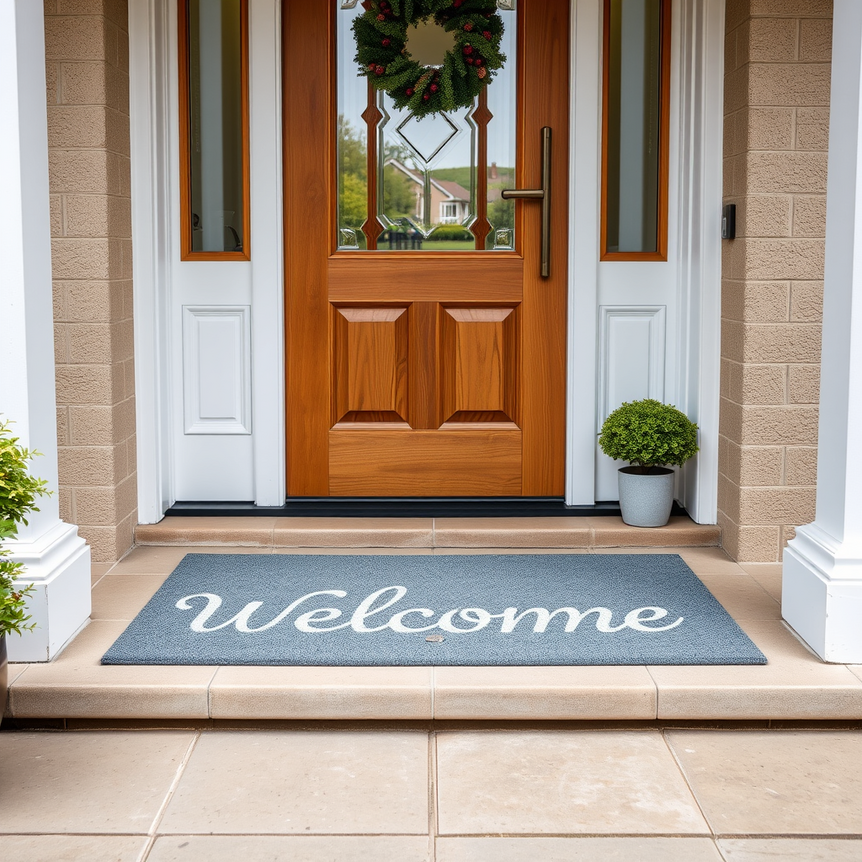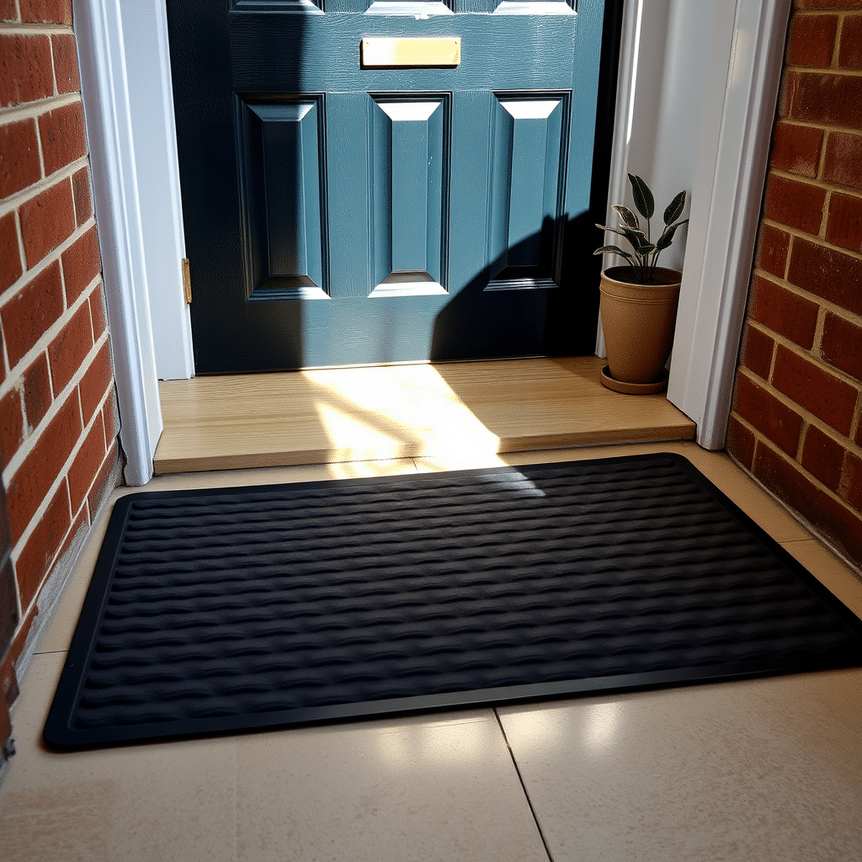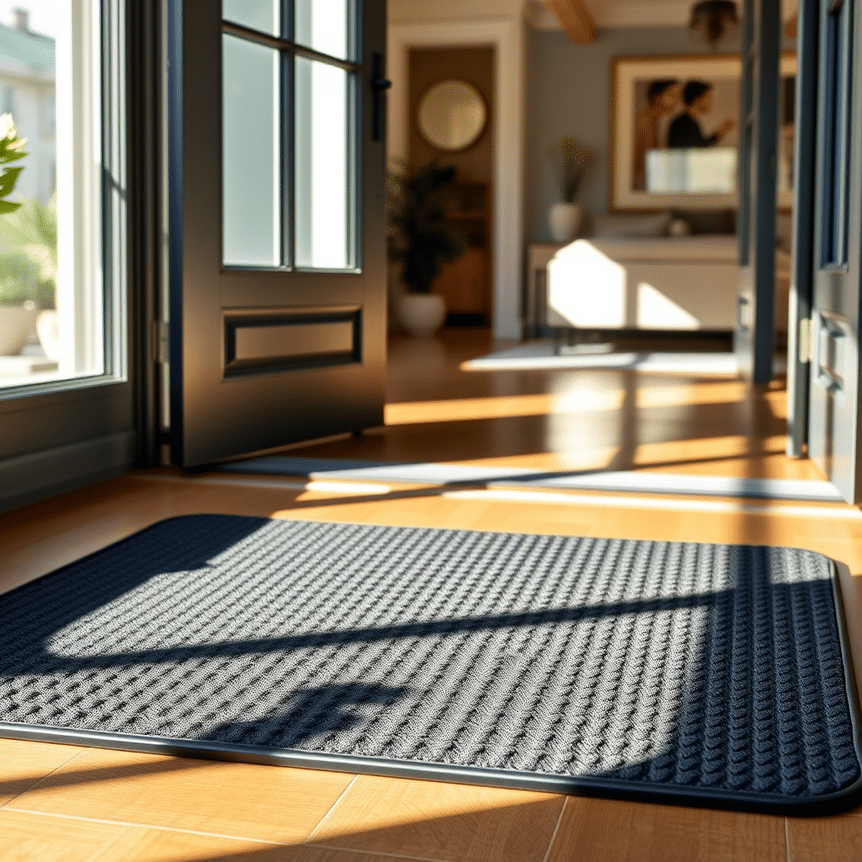Have you ever wondered why some door mats seem to capture dirt effortlessly while others appear to barely make a dent in keeping your home clean? The secret often lies not solely in the material, but crucially, in the size. A perfectly fitted barrier door mat works as your home’s first line of defence against dirt, moisture, and debris—but only if it’s the right size for your specific entrance. In this comprehensive barrier door mat size guide, we’ll show you exactly how to measure, select, and position the ideal mat for any doorway in your UK home, ensuring optimal performance and floor protection.
Why Barrier Door Mat Size Actually Matters
Many homeowners make the mistake of buying the first mat that catches their eye without considering proper sizing. But here’s the reality: an entrance mat that’s too small is practically useless, failing to effectively trap dirt and moisture, while one that’s too large can become a tripping hazard or even obstruct your door’s operation, leading to damage.
According to recent interior design surveys, 68% of UK homeowners report higher cleaning frequency during rainy seasons when using improperly sized mats. A well-fitted barrier door mat can reduce tracked-in dirt by up to 80%, saving you countless hours of cleaning and significantly extending the life of your floor coverings. This effectiveness is directly tied to the mat’s ability to facilitate multiple foot swipes, ensuring shoes are thoroughly cleaned before entering your living space.
“Size is the most overlooked factor when selecting an entrance mat,” explains Sarah Jennings, an interior designer with over 15 years of experience in UK home styling. “I’ve seen beautiful, expensive rugs ruined simply because the barrier door mat was too small to do its job properly, allowing grit and moisture to be carried further into the home.”
Understanding UK Door Measurements
Before you can choose the right barrier door mat size, you need to know your door measurements. UK homes vary considerably, from historic Victorian properties to modern new builds. Here’s a general overview of what you’re likely working with, though measuring your specific doorway is always essential:
- Standard Single Front Doors: Typically 76-92cm wide (30-36 inches). These are the most common for terraced and semi-detached homes.
- Back/Side Doors: Often narrower at 71-76cm (28-30 inches), commonly leading to kitchens or utility areas.
- Double Doors: Commonly 142-182cm wide (56-72 inches), found in larger detached homes or period properties.
- French Doors/Balcony Doors: Varies significantly but often 122-152cm (48-60 inches), providing access to gardens or balconies.
It’s important to note that older UK properties (particularly Victorian and Edwardian homes) often feature non-standard door sizes and uneven thresholds, so precise measuring is critical rather than guessing. Always measure the actual space where the mat will sit, not just the door itself.
Your Complete Barrier Door Mat Size Guide
When it comes to selecting the ideal size of your entrance mat, three key principles should guide your decision, ensuring maximum dirt-trapping efficiency and safety:
1. The 80% Width Rule
Your barrier door mat should cover at least 80% of your doorway’s width. This crucial guideline ensures visitors naturally step onto the mat without having to consciously aim for it, effectively covering the primary foot traffic zone.
- For a standard UK single door (approximately 84cm/33 inches wide): Choose an entrance mat that’s at least 67cm (26.5 inches) wide to provide ample coverage.
- For double doors (approximately 152cm/60 inches wide): Select a large door mat that’s at least 122cm (48 inches) wide to span the entire opening.
This isn’t arbitrary—the 80% guideline comes from extensive foot traffic studies showing that people naturally tend to walk within this central corridor of a doorway. A mat adhering to this rule will significantly improve dirt and moisture capture.
2. Minimum Length Requirements
Width is only half the equation for effective cleaning. Your mat’s length determines how thoroughly dirt and moisture get removed from footwear, allowing for multiple footstep cycles.
- Single Doors: A minimum length of 120cm (47 inches) is recommended to allow for at least two complete footstep cycles (e.g., left foot, then right foot) on the mat.
- Double Doors: Opt for a length of 150-180cm (59-71 inches) for proper coverage across the wider entrance, accommodating two people walking side-by-side.
- Commercial or High-Traffic Areas: For very busy entrances in homes or light commercial settings, consider lengths up to 300cm (118 inches) to accommodate multiple steps and higher volumes of foot traffic.
“Most people underestimate how much length matters,” notes James Carter, a flooring specialist at the British Floorcare Association. “A standard 18×30 inch (approx. 45x75cm) mat simply doesn’t provide enough surface area for effective dirt removal. You need enough length to take two full steps—first with your dominant foot, then with the other—to truly scrub off debris.”
3. Profile Height Considerations
The thickness, or profile height, of your barrier door mat is crucial for ensuring proper door clearance and maintaining accessibility:
- Standard Entrance Mats: Typically 1.5-2.5cm (0.6-1 inch) thick, suitable for most doorways with adequate clearance.
- Deep-Cleaning Mats: Some highly absorbent or textured mats designed for heavy dirt loads might be 3-4cm (1.2-1.6 inches) thick. Ensure your door clears these types.
- Low-Profile Mats for Narrow Thresholds: For doors with very little clearance or where accessibility is paramount, opt for mats under 1.5cm (0.6 inches).
If you have elderly residents, wheelchair users, or pushchairs in your household, always opt for lower profile mats to ensure smooth and safe transitions, preventing tripping hazards. Be sure to measure your door’s clearance height (the gap between the bottom of the door and the floor/threshold when the door is fully open) before purchasing, especially for heavily textured mats that might prevent the door from closing properly or cause damage.
Barrier Door Mat Size Recommendations for Different Entrances
To simplify your selection process, here’s a helpful table summarising recommended barrier door mat sizes for common UK doorways. These are general guidelines, so always double-check your specific measurements.
| Door Type | UK Door Width (Approx.) | Recommended Mat Size (Approx.) | Ideal For | Key Benefit |
|---|---|---|---|---|
| Standard Single Front Door | 76-92cm (30-36 inches) | 60x85cm (24×33 inches) or 90x150cm (35×59 inches) for extended coverage | Most UK terraced and semi-detached homes, apartment entrances | Provides excellent coverage for single entry, capturing dirt effectively with 1-2 steps. |
| Double Front Doors | 142-182cm (56-72 inches) | 115x180cm (45×71 inches) | Larger detached homes, period properties with grand entrances | Spans the entire entryway, accommodating two people entering simultaneously. |
| Back/Side Door | 71-76cm (28-30 inches) | 40x60cm (16×24 inches) or 50x75cm (20×30 inches) | Kitchen entrances, utility rooms, narrow side passages | Compact enough for smaller, high-traffic areas while still providing effective cleaning. |
| Balcony/French Doors | 122-152cm (48-60 inches) | 90x150cm (35×59 inches) | Modern apartments, garden entrances, conservatories | Accommodates the wider swing of French doors and provides sufficient cleaning surface for garden debris. |
| High Traffic/Commercial | Varies | 120x200cm (47×79 inches) or larger custom sizes | Bustling family homes, home offices with client visits, small businesses | Designed for extensive dirt and moisture absorption over multiple steps, maintaining cleanliness in busy areas. |
Pro Tips for Measuring Your Entrance
Measuring properly is the single most important step in our barrier door mat size guide. Follow these steps for professional results and to avoid common sizing mistakes:
- Measure Width Accurately: Using a metal tape measure, record the exact width of your doorway at the point where the mat will sit. Do this at three points: top, middle, and bottom—some older UK homes and even newer builds can have uneven door frames or thresholds. Take the narrowest measurement.
- Calculate Minimum Mat Width: Multiply your doorway’s measured width by 0.8 (for 80%) to determine the minimum mat width required for optimal coverage. This ensures your mat effectively covers the main footfall area.
- Test Ideal Length: Stand at your entrance (inside or outside, depending on where the mat will primarily be) and take two natural steps forward as if entering. Mark where your second foot lands—this is your ideal mat length. For high-traffic areas, consider a slightly longer mat to allow for more dirt and moisture removal.
- Check Door Clearance: Open your door fully and measure the space between the bottom of the door and the threshold or floor. Your barrier door mat must be thinner than this measurement to ensure the door can open and close freely without dragging or catching, which can damage both the door and the mat.
- Consider Traffic Flow: Observe how people naturally enter your home. Do they tend to enter slightly to one side? Adjust your potential mat placement accordingly to maximise its dirt-trapping effectiveness. If an external mat won’t fit, consider an internal ‘secondary’ barrier mat.
Special Considerations for UK Homes
The unique characteristics of UK homes and our specific climate require a thoughtful approach when selecting barrier door mats.
Weather Adaptation
UK weather presents unique challenges, particularly our often damp and rainy climate. During our notorious rainy seasons (particularly October-March), you’ll want to prioritise length to maximise moisture absorption and allow for more thorough drying of footwear. Consider a longer entrance mat (150cm/59 inches or more) even for single doors during these months, as it will significantly reduce the amount of water and mud tracked indoors.
Historic Properties
If you live in a listed building or period property with non-standard door sizes, unusually thick walls, or uneven stone thresholds, don’t compromise on your barrier door mat. Standard sizes may not fit or perform optimally. Rugstars offers fully customizable barrier door mats to fit any unique entrance perfectly—simply provide your precise measurements when ordering for a bespoke solution.
Multi-Season Strategy
Many savvy UK homeowners rotate mats seasonally to adapt to changing weather conditions and aesthetic preferences:
- Summer: Thinner, decorative entrance mats (e.g., 40x60cm or 50x75cm) might suffice when there’s less mud and rain.
- Autumn/Winter: Switch to thicker, highly functional barrier door mats (e.g., 60x85cm or larger, perhaps with coarser fibres) designed for heavy-duty dirt and moisture capture during wet and muddy conditions.
- Spring: Use mid-weight mats that can handle occasional mud and dampness (e.g., 50x75cm) as the weather becomes more unpredictable.
Common Mistakes to Avoid
As we wrap up this barrier door mat size guide, be mindful of these frequent sizing errors that can undermine your mat’s effectiveness and your home’s cleanliness:
- Choosing based on aesthetics alone: While a mat’s look is important, its primary function is dirt and moisture trapping. Beauty won’t matter if the mat doesn’t perform its duty.
- Ignoring seasonal needs: A small, thin summer mat simply won’t cut it during harsh UK winter storms or heavy autumn rain, leading to wet, muddy floors.
- Measuring the door rather than the entrance area: The door frame is often narrower than the usable floor space. Focus on where people actually step and where the mat will sit flat.
- Forgetting about clearance height: This is a critical oversight that can lead to constant door obstruction, damage to the door’s base, or the mat bunching up and becoming a tripping hazard.
- Assuming all single doors are the same size: UK homes, especially older ones, vary considerably. Always measure your specific doorway dimensions rather than relying on assumed standard sizes.
- Not considering the mat’s primary purpose: Is it for heavy dirt, light dust, or just decoration? Your mat’s purpose should inform its size and material.
Finding Your Perfect Barrier Door Mat
Selecting the right size for your barrier door mat isn’t just about measurements—it’s about creating an effective first line of defence for your home, protecting your floors, and significantly reducing your cleaning efforts. As this comprehensive barrier door mat size guide has shown, the perfect mat balances width, length, and profile height to create a seamless transition from outside to in, while maximising dirt and moisture capture, especially crucial in the varied UK climate.
At Rugstars, we understand the specific needs of UK homes. We offer an extensive selection of high-quality barrier door mats in all standard UK sizes, plus custom options for those trickier, non-standard entryways. Our UK-made mats feature:
- Deep-cleaning surfaces specifically designed for UK weather conditions, effectively trapping grit and absorbing moisture.
- Durable, non-slip backing suitable for all UK flooring types, including wood, laminate, tile, and carpet.
- Expert sizing recommendations personalised to your home’s specifications, ensuring a perfect fit and optimal performance.
Ready to find your perfect barrier door mat? Measure your entrance using our detailed guide, then browse our comprehensive collection of expertly sized mats designed specifically for UK homes. Your floors (and your cleaning schedule) will thank you for making an informed choice for a cleaner, safer home.
Frequently Asked Questions About Barrier Door Mat Sizing
What is the ideal width for a barrier door mat in a standard UK home?
For a standard single front door in the UK (typically 76-92cm wide), your barrier door mat should cover at least 80% of the doorway’s width. This translates to a minimum mat width of approximately 60-75cm (24-30 inches) to ensure natural foot placement and effective dirt trapping.
How long should my barrier door mat be to properly clean shoes?
For single doors, a minimum length of 120cm (47 inches) is recommended. This length allows for at least two full steps to be taken on the mat, ensuring that both feet make contact and have enough surface area to effectively wipe off dirt and absorb moisture from footwear.
What does “profile height” mean for a door mat, and why is it important?
Profile height refers to the thickness of the door mat. It’s crucial because it determines whether your door can open and close freely over the mat without catching, dragging, or causing damage. Thicker mats (1.5-4cm) are great for deep cleaning but require sufficient door clearance, while thinner, low-profile mats (under 1.5cm) are ideal for narrow thresholds or where accessibility is key.
Can I get a custom-sized barrier door mat for my unusual doorway?
Yes, absolutely! For older UK properties or unique architectural designs that feature non-standard door sizes, custom-sized barrier door mats are often the best solution. Many suppliers, including Rugstars, offer bespoke options where you can provide precise measurements to ensure a perfect fit and maximum effectiveness.
Should I use different barrier door mats for summer and winter in the UK?
Yes, many savvy UK homeowners opt for a multi-season strategy. Thinner, more decorative mats might be suitable for drier summer months. However, during autumn and winter, it’s highly recommended to switch to thicker, more absorbent, and longer barrier door mats that are specifically designed to handle the increased mud, rain, and moisture characteristic of the UK’s colder, wetter seasons, maximising protection for your indoor flooring.



